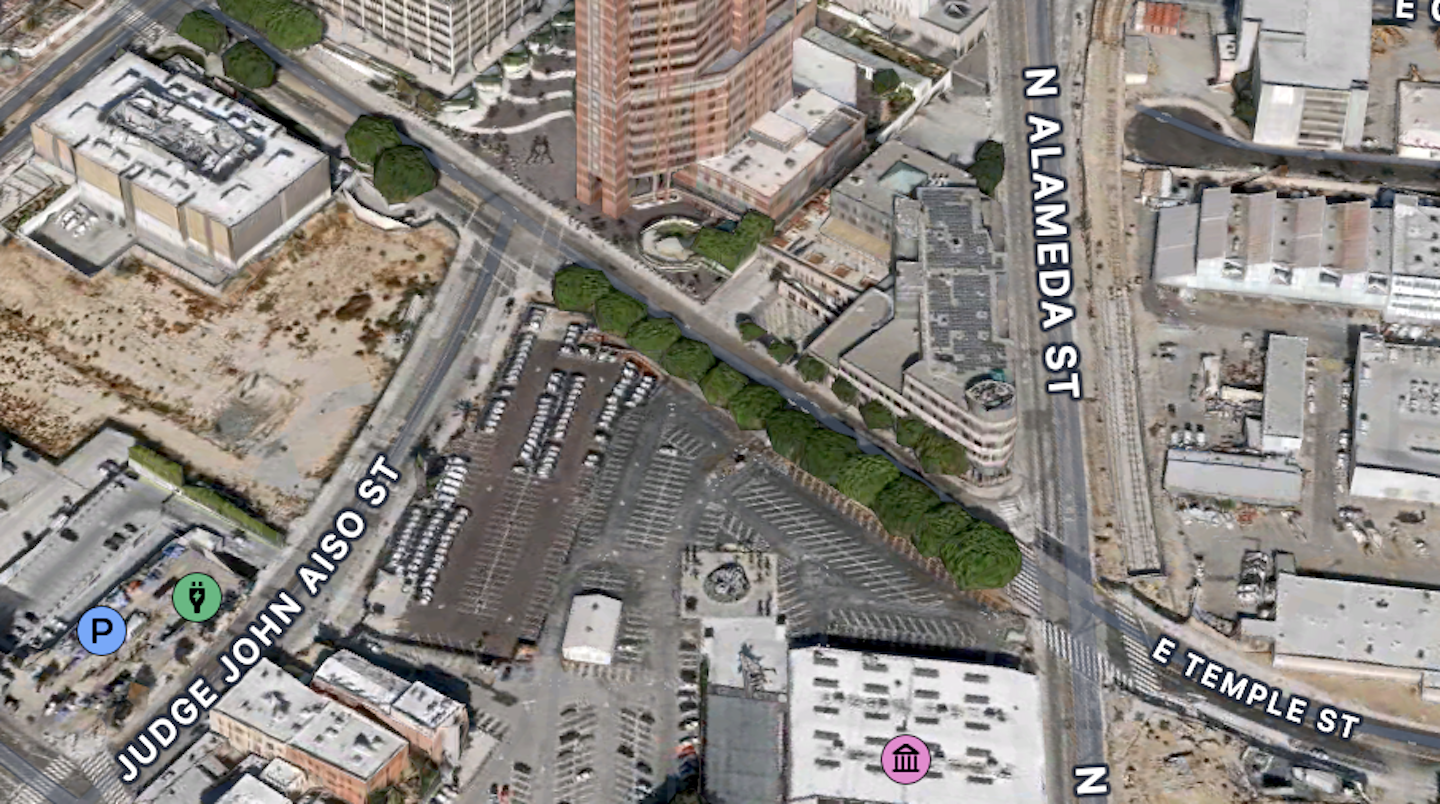
This image from Apple Maps shows the triangular area along Judge John Aiso and East Temple Streets in Little Tokyo where the First Street North project will be built. (Photo: Apple Maps)
First Street North breaks ground
on a transformative project for Little Tokyo.
By P.C. Staff
Whether one looks at it as an expansion for Little Tokyo or a return to what it used to encompass prior a long ago act of eminent domain that took the land for a parking lot, the end result will be the same. Little Tokyo’s 140-year-old footprint, demography, environs and destiny will change for decades to come, thanks to an ambitious new mixed-use development project called First Street North.
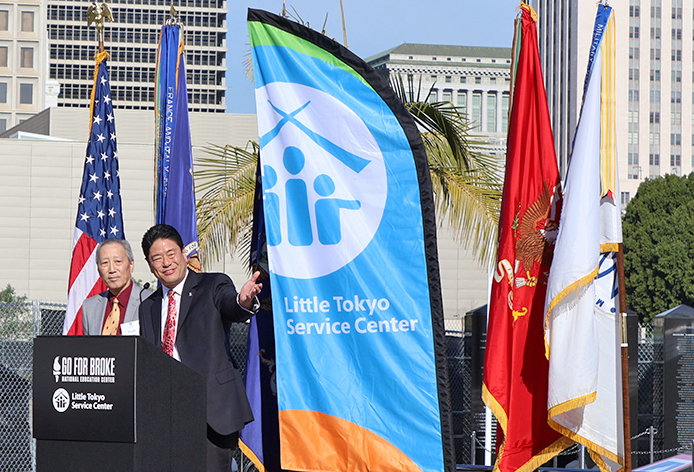
From left: LTSC’s Executive Director Erich Nakano and GFBNEC’s President and CEO Mitchell Maki address the audience at the First Street North’s groundbreaking ceremony. (Photo: George Toshio Johnston)
It was for those reasons that leaders, participants, stakeholders and everyday citizens from the civic, political, veterans, business and nonprofit domains came together on a sunny and cool morning on Feb. 13 for a ceremonial groundbreaking near Little Tokyo’s Go for Broke Monument.
As envisioned, First Street North will transform the area bounded by Judge John Aiso Street to the west and East Temple Street to the north to North Alameda Street with new construction that will not only mean 10,000 square feet of operating space for the Go for Broke National Education Center — one of the new development’s partners, along with the Little Tokyo Service Center and the City of Los Angeles, plus private and other government entities — but also 330,000 square feet of indoor space five stories high (with underground parking) that will include 248 affordable units for low-income individuals and families, 80 of which will be “permanent supportive units for unhoused people” and 63 units for homeless veterans.
Furthermore, when completed, the plan is for “legacy” businesses such as Fugetsu-Do and Suehiro Restaurant to relocate to the new development, which will also house an additional theater for East West Players. According to Mitchell Maki, president and CEO of GFBNEC, completion should be achieved by late 2026 at the earliest or spring 2027 at the latest.
Speaking last September at GFBNEC’s annual Evening of Aloha gala, former Alhambra Mayor Jeff Maloney said the new space will include “a multipurpose room for presentations and community meetings, a state-of-the-art conference room and a temporary exhibit space, and I think most exciting, an outdoor courtyard that will be designed to give the proper honor to every person whose name is inscribed on our monument.”
Maloney added that part of the development would include an interpretive center next to the Go for Broke Monument, as well as an additional commemorative wall to include 16,000 Japanese American service members who served during World War II but were not sent overseas.
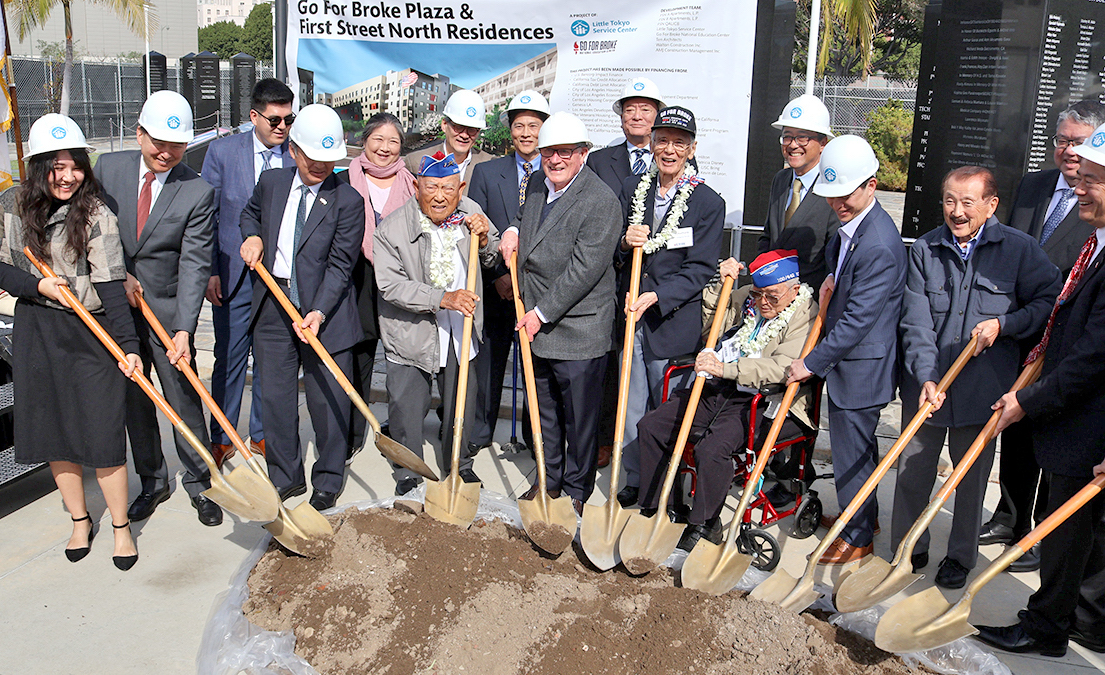
Wearing hardhats and with shovels in hand, a group of First Street North supporters, including WWII veterans Toke Yoshihashi, Ed Nakamura and Yoshio Nakamura, during the Feb. 13 groundbreaking in Little Tokyo (Photo: George Toshio Johnston)
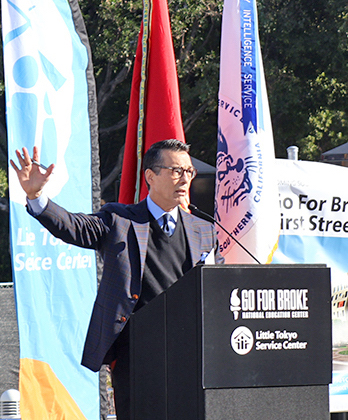
KABC Channel 7 news anchor David Ono serves as the master of ceremonies at the Feb. 13 groundbreaking for First Street North in Little Tokyo. (Photo: George Toshio Johnston)
The February groundbreaking began with a rousing taiko performance by J-Town Taiko Club, after which KABC-TV news anchor David Ono took over as master of ceremonies, introducing such speakers as Little Tokyo Service Center Executive Director Erich Nakano and GFBNEC’s Maki, who recognized three Japanese American Army veterans in the audience: Ed Nakamura, who served in the Military Intelligence Service; Yoshio Nakamura, who served in the 442nd Regimental Combat Team; and Tokuji “Toke” Yoshihashi, who served in the 100th Infantry Battalion.
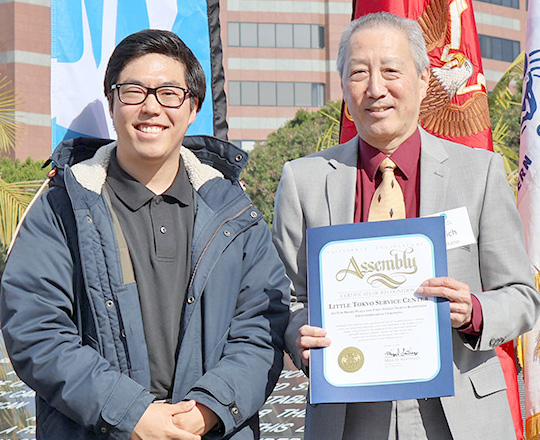
Eric Moon, field representative for Assemblymember Miguel Santiago, after presenting LTSC’s Erich Nakano with a certificate of recognition to commemorate the First Street North groundbreaking (Photo: George Toshio Johnston)
Other speakers that morning chosen to give some remarks about their particular organization’s contribution to the project included attorney Bill Seki, a partner at law firm Seki, Nishimura and Watase; City of Los Angeles Deputy Mayor of Housing Jenna Hornstock; Los Angeles City Councilmember Kevin de Leon; Consul General of Japan in Los Angeles Kenko Sone; Senior VP of U.S. Bank Impact Finance Lisa Gutierrez; Little Tokyo Service Center Director of Real Estate Debbie Chen; Field Representative for Assemblymember Miguel Santiago Eric Moon; L.A. Development Fund President and City of L.A. Economic Workforce Development Department General Manager Carolyn Hull; Genesis L.A. President and CEO Thomas De Simone; and LTSC Community Development Director Takao Suzuki.
Suzuki recognized some of the dignitaries in the audience that morning, including former L.A. City Councilmember Jan Perry, who represented Little Tokyo; former state Assemblymember George Nakano; Alhambra’s Maloney; and former L.A. School Board member and former State Assemblyman Warren Furutani.
Also making remarks that morning were Little Tokyo Community Council Managing Director Kristin Fukushima; California Wellness Foundation Program Director Jamie Schenker; Home Depot Foundation Store Manager and District Team Depot Captain Luis Miguel; California Community Foundation Housing and Economic Opportunity Director Maria Cabildo; and National Equity Fund Managing Director Debbie Burkart.
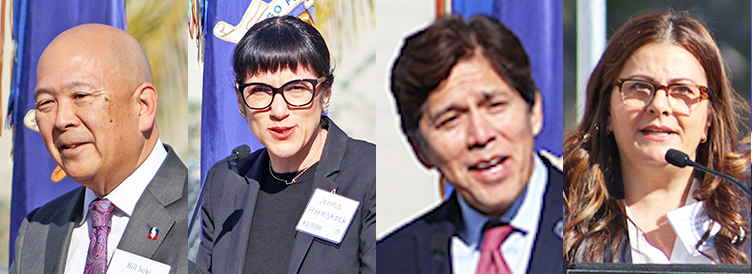
From left: Bill Seki, Esq., of the law firm Seki, Nishimura and Watase on Feb. 13 in Little Tokyo; City of Los Angeles Deputy Mayor of Housing Jenna Hornstock; Los Angeles City Councilmember Kevin de Leon; and Senior VP of U.S. Bank Impact Finance Lisa Gutierrez (Photos: George Toshio Johnston)
LTSC’s Chen, the final speaker before the groundbreaking said, “We want to thank all the community organizations and stakeholders that have been involved, that have given public comment, that have invested their time and their resources into realizing the vision for this project. And I want to do a special acknowledgement to the Little Tokyo small businesses that have provided their thoughts and their feedback, and we hope to see many of them in the building when it comes online.”



